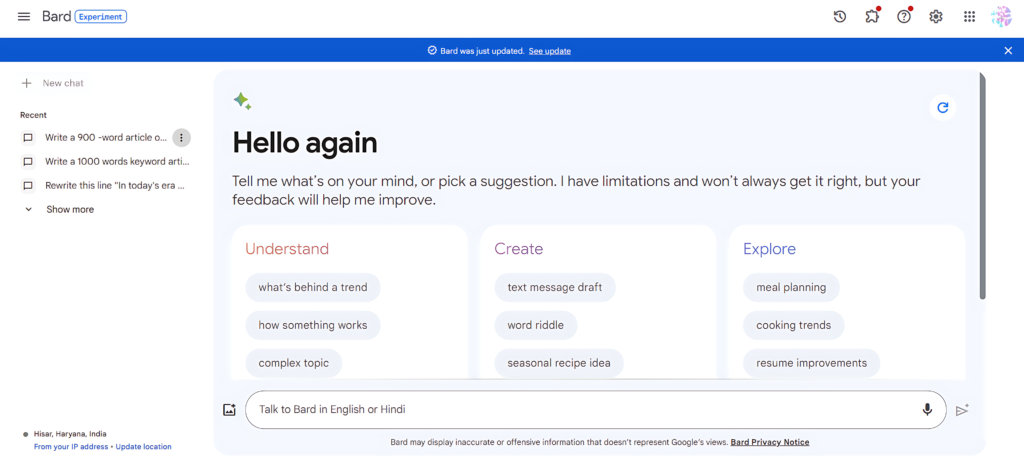In the realm of artificial intelligence-driven content creation, Google Bard emerges as a beacon of innovation and efficiency. The content creation landscape has been transformed by AI-powered tools, but Google Bard stands out distinctly, setting new standards and redefining expectations. In this article, we will delve into what makes Google Bard superior to other AI content generators and provide insights into how it operates.

Table of Contents
Google Bard vs. Other AI Content Generators
1. Contextual Understanding:
Google Bard possesses a remarkable ability to grasp and generate content with a deep understanding of context. Unlike some other AI content generators that might produce generic and contextually inaccurate content, Google Bard excels in comprehending nuances, resulting in more coherent and relevant output.
2. Natural Language Flow:
The content generated by Google Bard exhibits a natural language flow that rivals human-generated content. This is a significant advantage over various AI content generators that often produce stilted or disjointed sentences. Google Bard’s ability to mimic human language elevates the quality of the content it generates.
3. Multi-Platform Integration:
This tool seamlessly integrates across multiple platforms and devices, making it incredibly versatile. Some other AI content generators might have limitations in terms of compatibility and usability, restricting the user’s freedom to create content across various platforms efficiently.
How is Bard different from other AI content generators?
One of the key differences between Bard and other AI content generators is that Bard has access to Google Search. This means that Bard can provide more comprehensive and up-to-date information in its responses. Additionally, Bard is still under development, but Google is actively working to improve its capabilities.
4. Customization and Control:
This AI tool offers a higher degree of customization and control over the generated content. Users can easily modify the tone, style, and structure according to their specific requirements. Other AI content generators may lack this level of flexibility and precision.
5. Multi-Lingual Capabilities:
Google Bard is adept at generating content in multiple languages, breaking down language barriers. In contrast, certain AI content generators might have limitations regarding language options, making Google Bard a more inclusive and globally accessible tool.
How Google Bard Works?

This AI tool operates on a complex neural network architecture, employing state-of-the-art deep learning algorithms. Here is a simplified explanation of its functioning:
1. Data Collection and Analysis:
This AI tool begins by collecting and analyzing a vast amount of data from various sources, including books, articles, and websites. This data serves as the foundation for understanding linguistic patterns and context.
2. Natural Language Processing (NLP):
The AI system processes the collected data using Natural Language Processing (NLP) techniques. NLP helps in breaking down sentences into words, understanding their meanings, and identifying grammatical structures.
3. Pattern Recognition:
Google Bard’s neural network identifies patterns and correlations within the processed data. It learns from the vast amount of information it has been fed, including how words are used in different contexts and the relationships between them.
4. Training and Fine-Tuning:
Through extensive training and fine-tuning, This AI tools’s neural network refines its understanding and application of language rules. This iterative process helps the AI to improve its language generation capabilities.
5. User Interaction:
When a user inputs a topic or a prompt, Google Bard’s neural network applies the learned patterns and rules to generate coherent and contextually appropriate content. The more the AI is used, the better it becomes at generating high-quality, natural-sounding content.
In essence, Google Bard’s functioning is a blend of sophisticated algorithms, extensive data analysis, and machine learning, all working in harmony to produce impressive, human-like content.
Conclusion
Google Bard has emerged as a trailblazer in the AI content generation domain, showcasing superior contextual understanding, natural language flow, multi-platform integration, customization options, and multi-lingual capabilities. Its intricate neural network architecture and sophisticated algorithms enable it to comprehend context and generate content that mirrors human-created material. With its continual evolution and improvement, This content writing tool is undoubtedly spearheading the future of AI-driven content creation.

1 thought on “Google Bard vs. Other AI Content Generators”